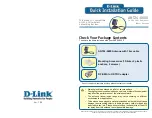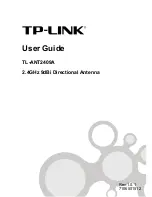
NOTE
Failure to follow recommendations and instructions in this manual may void the
manufacturer’s warranty. Please review Nautel’s warranty for more information.
CL40 Antenna Technical Instruction Manual
Page 2-1
Section 2 Preparation for Use and Installation
Issue 3.0
CL40 ANTENNA
TECHNICAL INSTRUCTIONS
Section 2
PREPARATION FOR USE AND INSTALLATION
2.1 INTRODUCTION
This section contains installation information
for the antenna. Nautel recommends that all
requirements be incorporated to ensure
optimum reliability and performance.
2.2 SITE SELECTION
The antenna’s intended application dictates
its general location. Consider the following
factors when selecting a site:
•
The area near the antenna should be
free from other fixed structures (e.g,
overhead power lines, other antennas).
•
The material already in place should be
of sufficient depth and competence to
support the antenna base (see 2.3 for
base installation options).
•
Consider the potential difficulties that
may be encountered when burying the
ground mat.
2.3 BASE INSTALLATION
Once the specific site has been selected,
excavate for, as necessary, and install the
base as detailed in Figure 2-3a (standard
concrete base, see also 2.3.1) or 2-3b
(non-standard base, see also 2.3.2).
NOTE
Various factors can affect the installation of
the selected antenna base. Refer to the
General Notes in Figure 2-3a if using a
standard concrete base.
Top Loading Kit: If you purchased the Top
Loading Kit (Nautel # 199-9085), see Figures
2-17 and 2-18 to prepare your location and
install the foundation and guy wires. Use
Table 2-3, not Table 2-1, to configure the
loading coils.
Guy Wire Kit: If you purchased the Guy
Wire Kit (Nautel # 199-9087), see Figures
2-17 and 2-19 to prepare your location and
install the foundation and guy wires.
Consult a local Civil Engineer prior to
installing the antenna base to ensure proper
installation and – in the case of the non-
standard base – mounting hardware
selection and anchoring foundation design.
For all types of base mounting design
assuming a net overturning moment at the
top of the base of 18,500 ft-lbs.
2.3.1 Standard Concrete Base
For the standard concrete base (see
Figure 2-3a), the anchor post (item 26) is
cast in the concrete base. A 17/32”
diameter drain hole, 52” from the bottom
of the post can be used to determine the
depth to embed the anchor post in the
concrete. Embed the post in the concrete
such that this drain hole is approximately
4” above the concrete. Keep the drain
hole clear. Ensure that the anchor post is
maintained perfectly plumb until the
concrete has set. Orient the 17/32“
diameter holes at the top of anchor post
at right angles to the intended axis of the
laid down antenna.
2.3.2 Non-Standard Base
For the non-standard base (see Figure
2-3b), the anchor post is part of a welded
base that includes a base plate and
support gussets. A 9/16 in. diameter drain
hole is located above the base plate.
2.4 ANTENNA ASSEMBLY AND
ERECTION
Use Figures 2-1 and 2-2, which depict the
complete assembly of the antenna, in
conjunction with the following instructions.














































